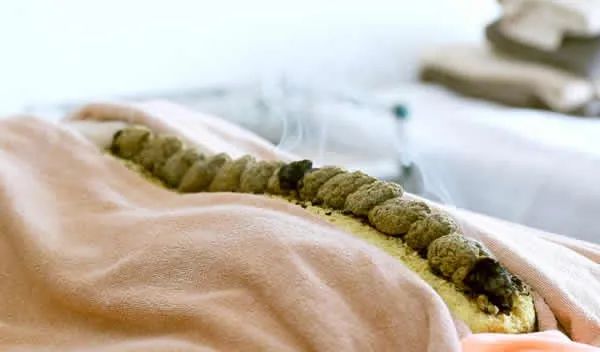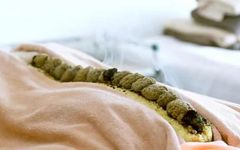Yang deficiency has many characteristics, with a particular sensitivity to cold being a manifestation of weakened yang qi. In most cases, many people suffer from yang qi damage without realizing it, and instead, they are inexplicably troubled by common illnesses. If they frequently receive cold antibiotic treatments as a result, it is akin to adding insult to injury.
● Recurrent colds, ginger moxibustion during spring and summer
Dr. Li Ke, a seasoned TCM practitioner with decades of experience in reviving patients, summarized a famous saying: “In critical moments of life and death, saving yang is urgent.”
Clinically, he has seen too many cases where modern living, especially the widespread use of air conditioning, has led to diseases caused by yang deficiency. The most common include: headaches, chronic rhinitis, summer heat syndrome, persistent colds, unexplained diarrhea, high fever, childhood asthma, as well as women’s dysmenorrhea, postpartum issues, inflammation, and men’s impotence and prostatitis.
Yang deficiency has many characteristics, with a particular sensitivity to cold being a manifestation of weakened yang qi. In most cases, many people suffer from yang qi damage without realizing it, and instead, they are inexplicably troubled by common illnesses. If they frequently receive cold antibiotic treatments as a result, it is akin to adding insult to injury.
Another confusion we face is the difficulty in finding good doctors and the declining quality of herbal medicines. Therefore, in such an era, moxibustion becomes particularly precious! It is a remedy that everyone can use with confidence, allowing us to truly become our own doctors.
As the saying goes: “Keep moxa at home, and the young and old will be free from ailments.” This saying is particularly classic in today’s context of widespread yang qi deficiency.
A person’s life is a process of gradually depleting yang qi. Many people’s bodies are in a sub-healthy state; clinically, everyone often feels unable to wake up, reluctant to rise in the morning, and lacking energy even when they do. Some feel a heavy mood and a heavier body. From a TCM perspective, any dark and damp corner must be a place where sunlight cannot reach. It can be said that the dampness in this person’s body is excessive, indicating a state of yang qi deficiency, even if they are not yet severely cold-sensitive.
Thus, I believe that what Dr. Li referred to as deficiency is not merely yang deficiency constitution, but rather a general imbalance of yin and yang. Air conditioning, of course, is an important factor contributing to the widespread yang deficiency in modern people, although many are still unaware of this.
Traditional Chinese Medicine emphasizes “nurturing yang in spring and summer.” During this time, a large amount of yang qi rises to the surface of the earth, making plants flourish and people’s vitality the strongest, with hot weather. Sweating profusely is meant to expel waste and toxins from the body. Today, when you go outside, it feels like a fire. However, upon returning home, you immediately enter a cold environment with air conditioning. This way, coldness is layered into the body. These trapped cold energies are the root of diseases and pathogens.
Young people, those with good health, have strong vitality and may not experience problems temporarily. However, everyone has moments of weakness. Pathogens are quite patient; once your body weakens, they will start to rebel, leading to many illnesses.
The saying “disease enters through the mouth” refers not only to bacteria and viruses but also to coldness. Coldness enters from the outside and causes chaos within the body, which is the true cause of illness. Using moxibustion to drive it out will cure the disease.
Therefore, spring and summer are key seasons for treating diseases. If we can use the heat of moxibustion to assist in elevating yang qi, cleansing the body once a year will lead to better health. Those without illness will nourish their yang qi and improve their health; those with illness will reduce the accumulated pathogens, making recurrence less likely and even allowing for gradual recovery.
I suggest that, if conditions allow, family members can assist with moxibustion during the summer.

When using moxibustion for treatment, fresh ginger is generally used as a base. This method of moxibustion, where something is placed between the moxa and the skin, is called ginger moxibustion, a technique invented by the physician Ge Hong during the Jin Dynasty, which has significantly influenced the development of moxibustion methods in later generations.
Ginger moxibustion involves kneading a mixture of flour and medicinal powder into small conical shapes, placing them on slices of ginger, and then stacking them along the Du Mai (Governing Vessel) from the Da Zhui (Great Vertebra) point downwards, inserting moxa sticks into the dough and igniting them. However, after such treatment, the patient’s back will develop blisters, which can be painful and leave scars once they burst.
If it is just for general health, family members can assist with ginger moxibustion.
Ginger moxibustion involves placing slices of fresh ginger, cut to about 0.2-0.3 cm thick, between the moxa and the skin. Of course, this thickness can be adjusted according to individual constitution. For example, some people are very sensitive to the heat of moxa or are doing ginger moxibustion for the first time, so they may cut it a bit thicker to avoid burns. After becoming more skilled, small holes can be pricked into the ginger slices to facilitate the transfer of heat.
We can arrange the ginger slices from the Da Zhui position down to the Yao Shu (Lumbar Shu) points.
Then take 3-5 moxa sticks, light them all at once, and move them from top to bottom. This can also be adjusted based on the situation; if the moxa sticks are thicker, use fewer, and if they are thinner, use more. The more bundled together, the stronger the heat. The distance between the moxa and the skin should be controlled by our own feeling, ensuring it does not burn or blister.
This health moxibustion can be done once a week or every half month, especially effective for cold and deficiency syndromes. If you feel that the Du Mai moxibustion is too much, you can focus on acupoints along the spine, either single points or combinations.
For example, single moxibustion at the Feng Men (Wind Gate) point.
Many people choose to get vaccinated or take Ban Lan Gen (Isatis Root) during flu outbreaks. I suggest everyone try ginger moxibustion at the Feng Men point.
The Feng Men point is located on the back and is an acupoint on the Tai Yang Bladder Meridian. According to the theory of the six meridians, it is the first barrier the external pathogens must cross to enter the body. The so-called Feng Men naturally refers to the portal that blocks the wind. Regularly moxibustion at this point enhances its function, allowing it to better guard the entrance. Moxibustion once a day for 5-10 minutes for 10 consecutive days will naturally keep colds at bay.
If you just have a slight cold and a runny nose, at this moment, the body’s yang qi is battling the invading pathogens. Quickly moxibustion at the Feng Men point to assist it in driving out the wind pathogen, and this time, you can successfully avoid the cold.

